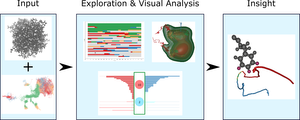Information
- Publication Type: Conference Paper
- Workgroup(s)/Project(s): not specified
- Date: 2017
- Location: September, 2017 Bremen, Germany
- Lecturer: Viktor Vad
- Booktitle: Eurographics Workshop on Visual Computing for Biology and Medicine 2017
- Conference date: 2017 –
- Pages: 33 – 42
Abstract
The function of proteins is tightly related to their interactions with other molecules. The study of such interactions often requires to track the molecules that enter or exit specific regions of the proteins. This is investigated with molecular dynamics simulations, producing the trajectories of thousands of water molecules during hundreds of thousands of time steps. To ease the exploration of such rich spatio-temporal data, we propose a novel workflow for the analysis and visualization of large sets of water-molecule trajectories. Our solution consists of a set of visualization techniques, which help biochemists to classify, cluster, and filter the trajectories and to explore the properties and behavior of selected subsets in detail. Initially, we use an interactive histogram and a time-line visualization to give an overview of all water trajectories and select the interesting ones for further investigation. Further, we depict clusters of trajectories in a novel 2D representation illustrating the flows of water molecules. These views are interactively linked with a 3D representation where we show individual paths, including their simplification, as well as extracted statistical information displayed by isosurfaces. The proposed solution has been designed in tight collaboration with experts to support specific tasks in their scientific workflows. They also conducted several case studies to evaluate the usability and effectiveness of our new solution with respect to their research scenarios. These confirmed that our proposed solution helps in analyzing water trajectories and in extracting the essential information out of the large amount of input data.Additional Files and Images
Weblinks
BibTeX
@inproceedings{vad_viktor-2017-WVE,
title = "Watergate: Visual Exploration of Water Trajectories in
Protein Dynamics",
author = "Viktor Vad and Jan Byska and Adam Jurcik and Ivan Viola and
Eduard Gr\"{o}ller and Helwig Hauser and Sergio M. Margues
and Jiri Damborsky and Barbora Kozlikova",
year = "2017",
abstract = "The function of proteins is tightly related to their
interactions with other molecules. The study of such
interactions often requires to track the molecules that
enter or exit specific regions of the proteins. This is
investigated with molecular dynamics simulations, producing
the trajectories of thousands of water molecules during
hundreds of thousands of time steps. To ease the exploration
of such rich spatio-temporal data, we propose a novel
workflow for the analysis and visualization of large sets of
water-molecule trajectories. Our solution consists of a set
of visualization techniques, which help biochemists to
classify, cluster, and filter the trajectories and to
explore the properties and behavior of selected subsets in
detail. Initially, we use an interactive histogram and a
time-line visualization to give an overview of all water
trajectories and select the interesting ones for further
investigation. Further, we depict clusters of trajectories
in a novel 2D representation illustrating the flows of water
molecules. These views are interactively linked with a 3D
representation where we show individual paths, including
their simplification, as well as extracted statistical
information displayed by isosurfaces. The proposed solution
has been designed in tight collaboration with experts to
support specific tasks in their scientific workflows. They
also conducted several case studies to evaluate the
usability and effectiveness of our new solution with respect
to their research scenarios. These confirmed that our
proposed solution helps in analyzing water trajectories and
in extracting the essential information out of the large
amount of input data.",
location = "September, 2017 Bremen, Germany",
booktitle = "Eurographics Workshop on Visual Computing for Biology and
Medicine 2017",
pages = "33--42",
URL = "https://www.cg.tuwien.ac.at/research/publications/2017/vad_viktor-2017-WVE/",
}


